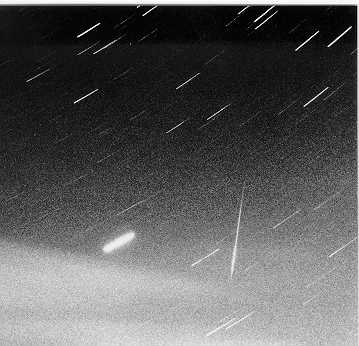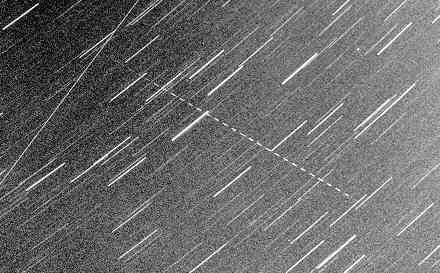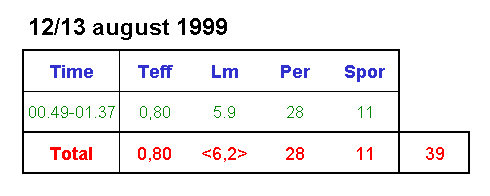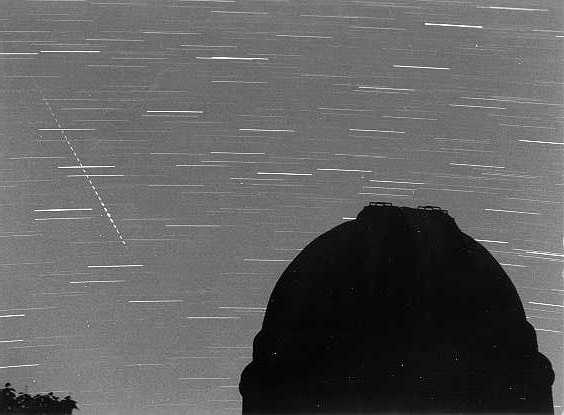- Links
- Newsflash : live from Biddinghuizen
- Visual report : by Marco Langbroek and Koen Miskotte at Biddinghuizen
- Photography : by Casper ter Kuile at Biddinghuizen
- Image Intensified Video : by Casper ter Kuile at Biddinghuizen
- Image Intensified Video : by Jan Boonstra at Weert, the Netherlands
- Visual observations : by Carl Johannink at Bad Fischau, Austria
- Visual observations : by Erwin van Ballegoij at Vep, Hungary
- Visual observations : by Jos Nijland at Schweich, Trier, Germany
- Radio observations : by Peter Bus at Ondrejov, Czech Republic
- Photography : by Jaap van 't Leven at Ondrejov, Czech Republic
- Observations : by Hans Betlem at Kunzak, Czech Republic
- IMO Shower Circular : by Rainer Arlt
- The Discovery of the Perseid Meteors : by Mark Littmann (S&T)
Immediately after the Eclips is over we will be heading to Biddinghuizen to observe the Perseids from there. Read our first impressions live (!!) from Biddinghuizen at this location!
 |
Geographical coordinates: longitude 5d37m23,4s east ; latitude 52d28m42,2s north.
- Perseids '99 in NAMN Notes : North American Meteor Network (NAMN)
- Perseid meteor shower this week! : Nasa Science News
- Snagging a High Fly Ball : Nasa Science News
No outburst was observed so far. It is now 1 UT. The weather is very changable.
So we have to stop observations often.
Koen observed a few fireballs during twilight. This might have been the decending slope of an outburst?
We do not know and are eagerly awaiting reports from other observers around the globe especially those more easterly located.
More later....
This newsflash is prepared by Casper ter Kuile at our observing location Biddinghuizen.
A nice Perseid display here in the Netherlands, but iffy weather. A northwest wind over the warm North Sea and lake IJssel generated fields of clouds that went landinwards. Thus, observing was a coming and going of clouds, Lim. mags. went up and down, periods with full or partial cloud cover and some clear periods. Below a table with my data with cloud percentage not more than 25%. Clouds made us stop at 0h UT.
A nice activity nevertheless, preliminary calculations from data by Koen Miskotte and me suggest rather normal Perseid Zenith Hourly rates in the order of 60-80. Many rather bright Perseids, but not abnormal I suggest. No real signs of an outburst. Koen noted 2-3 fireballs in very early twilight though.
Most beautifull meteor was a kappa Cygnid appearing at 23:05:56 UT, -5 with flares and bright blue. Still enjoyed this night. Data in table below.
- Marco Langbroek
Dutch Meteor Society (DMS)
Date: August 12/13 1999
Loc.: Biddinghuizen, the Netherlands, 52d 29' N, 5d 37' E
Obs.: Marco Langbroek LANMA
UT Teff Lm Per kCyg dAqr Spo F
20:20-20:45 0.35 5.7 7 0 0 0 1.00
21:02-21:10 0.13 6.1 3 0 0 0 1.25
21:10-21:20 0.15 6.7 7 1 0 0 1.10
21:20-21:37 0.27 6.5 6 1 0 3 1.10
22:08-22:40 0.50 6.8 17 0 0 4 1.00
22:48-23:27 0.58 6.4 26 2 0 7 1.00
23:49-00:00 0.18 6.3 5 0 1 3 1.00
TOTAL 2.17 <6.4> 71 4 1 17 tot. 93
-5/ -3 -2 -1 0 +1 +2 +3 +4 +5 +6
Sporadics 0 1 0 0 0 2 4 2 5 3 0 2.82
Perseids 0 2 1 3 8 7 9 14 19 6 2 2.45
k Cygnids 1 0 0 0 1 1 0 0 1 0 0
d Aquarids 0 0 0 0 0 0 0 1 0 0 0
Date: August 12/13 1999
Loc.: Biddinghuizen, the Netherlands, 52d 29' N, 5d 37' E
Obs.: Koen Miskotte MISKO
Period UT Teff Lm K PER AQR CAP kCYG SPO TOT
20:20-20:45 0,42 5,8 0,9 6 0 0 0 0 6
21:02-21:37 0,58 6,6 0,9 19 0 0 0 5 24
22:06-23:00 0,80 6,5 0,9 33 2 0 1 7 43
23:00-00:00 0,72 6,2 0,9 29 1 0 2 5 37
The Perseids '99 have been photographed on august 12/13 from locations Biddinghuizen
and Alphen aan de Rijn by Casper ter Kuile and Robert Haas respectively
(both are members of team Delphinus).
At both locations exposures started at 20:30 UT exactly.
At Biddinghuizen at 22:33 UT the so called "low" array of camera's was put into
operation. Robert stopped and restarted his camera-array a number of times when
clouds made photographing useless. Casper photographed continuesly also under less
favourite conditions.
In Belgium two teams have been photographing too this night and we hope some
multistation photographed meteors will results from these efforts.
If we do have photographed any meteors we will publish these at this page.
Members of the Dutch Meteor Society (team Delphinus) use Canon T-70 SLR kamera's equipped with 50 mm lenses. These are stopped down to from 1.8 to 2.8 to have sharper images. One T-70 is equiped with a Command-Back-70 which controlles all other camara's. The command-back-70 can be programmed to have the T-70's automatically acquire 36 pictures every 15 minutes.
 |  |
| 85 mm camera-array | System "Haas" camera-array |
We use Kodak Tri-X Pan, or Kodak Tri-X 400 (not T-max-400!) and develop in HC-110 for about 5 (Pan) to 6 (400) minutes at 22 degrees Celsius. This combination results in fine high contrast negatives whereas T-max results in lesser contrast using the T-max developer.
Our exposuretime depends on the amount of light and clouds present. On dark nights (no moon, no citylight, no clouds) we use an exposuretime of 15 to 20 minutes for camera's at high elevation and 15 minutes at maximum for camera's at low elevation (aimed at 30 degrees elevation). In lighter conditions these exposuretimes are decreased.
8 films of the lower camera-array have been developed by the time you read this. And the bright kappa-Cygnid of 23h05m56s UT is captured quite well including the terminal flare! Now the negatives are dry we can investigate the images with help of a TL-light source. And yes! A lot more meteors appear to have been photographed. The bright Perseids of 22:46:20 UT in Aquarius (Koen) and the 22:51:03 UT also in Aquarius (Marco) have been discovered on the negatives. Some other meteors are photographed on the eastern hemisphere. Notably a Perseid at 22:33:30 (Marco) and a kappa-Cygnid at 23:11:37 (Koen & Marco) are photographed too.





- Casper ter Kuile
Dutch Meteor Society (DMS)
The Perseids '99 have been used to test a new Videosystem at station Biddinghuizen. At the same time Robert Haas at station Alphen aan/de Rijn tested the other videosystem which has been equipped with a new digital Panasonic NV-DA1 camcorder. The new videosystem at Biddinghuizen is equipped with a first generation DEP Image Intensifier Tube consisting of 3 stages. The diameter of the photocathode is 25 mm which results in a field of view of about 28 degrees when using a standard 50 mm lens. This system is equipped with the Panasonic NV-DA1 digital camcorder, just as the other system.
The tests have been successful. The new tube of the system at Biddinghuizen performed well. While this was a preliminary test setup it proved not suitable for prolonged operation. The system in Alphen a/d Rijn did have some little problems with respect to correct focussing. Also we experienced a very changeble weathersituation which prevented multistation video work by Casper ter Kuile from Biddinghuizen and Robert Haas from Alphen a/d Rijn.
These tests were carried out in order to be fully prepared for the
Leonids in november. We presume the "old" videosystem of Carl & Casper and the videosystem
of Romke both will be equipped with new digital camcorders. These both systems will be
setup for multistation video work.
The other "new" videosystem of Carl & Casper will serve as all-sky monitoring system.
This system will record all bright meteors which might be photographed by the
camera-array's setups.
- Casper ter Kuile
Dutch Meteor Society (DMS)
 |
Jan Boonstra
Polakkers 25
9528 RD Buinen
Phone: 0599212355
E-Mail: janbobui@tref.nl
Date : 13/14 august 1999 Observer: Johannink, Carl (IMO-code: JOHCA) Place : Bad Fischau (Austria) Coord. : 16o 10' E ; 47o 50' N Start : 23:25 UT End : 01:30 UT 23:25-00:32 UT 22P;1kC;7spor 1.12 hour LM=6.0 00:32-01:30 UT 20P;2A;11spor 0.97 hour LM=6.0 stream:-3 -2 -1 0 1 2 3 4 5 average P 1 1 2 4 3 7 12 7 5 2.36 sp 0 0 0 0 1 0 5 9 3 3.72 kC 0 0 0 1 0 0 0 0 0 0.00 dA 0 0 0 0 0 0 0 2 0 4.00
Date : 23/24 august 1999
Observer: Johannink, Carl (IMO-code: JOHCA)
Place : Gronau (Germany)
Coord. : 07o 01' E ; 52o13' N
Center : R.A. = 00h; Decl. = 70 deg. at 01:00 UT
Start : 01:00 UT
End : 03:00 UT
Teff : 2.00 hours (no plotting)
Time(UT): k Cyg: P: d Aqr: n: LM: Notes:
01:00-02:00 0 3 1 17 6.1 only recording
02:00-03:00 1 2 0 20 6.0 >02:45 LM decr.
<-2 2 1 0 1 2 3 4 5 6 m: n: Per. 0 0 0 0 0 2 1 1 1 0 3.20 5 k Cyg. 0 0 0 0 0 0 0 1 0 0 4.00 1 d Aqr. 0 0 0 0 0 0 1 0 0 0 3.00 2 spor. 0 0 0 0 1 2 6 13 8 0 3.83 30 C.F. Johannink Schiefestrasse 36 48599 Gronau Germany Phone: + 49 2562 22345 Email: cjohannink@netside.de
Date : 04/05-09-99
Observer: Johannink, Carl (IMO-code: JOHCA)
Place : Lattrop (Netherlands)
Coord. : 06o 58'E ; 52o26'N
Center : R.A.=22h; Decl.=50 deg. at 21:00 UT
Start : 20:45 UT
End : 00:15 UT
Teff : 3.30 hours (plotting)
Time(UT): PSI: AUR: sp: n: LM: Notes:
20:45-21:45 2 0 12 14 6.3 0.94 hours, plotting
21:45-22:45 1 1 12 14 6.3 0.94 hours, plotting
22:45-00:15 1 2 17 20 6.3 >23:50 UT 6.1; 1.42 hours, plotting
<-2 2 1 0 +1 +2 +3 +4 +5 +6 m: n: Aurigids 0 0 0 0 0 0 2 1 0 0 3.33 3 Piscids 0 0 0 0 0 0 1 1 2 0 4.25 4 Sporadics 0 0 0 0 0 0 3 18 17 3 4.49 41 C.F. Johannink Schiefestrasse 36 48599 Gronau Germany Phone: + 49 2562 22345 Email: cjohannink@netside.de
For the eclips I travelled to Hungary (yes, I've seen it all!!!). I've
stayed four nights there. I used two nights to observe meteors. The
first night I was to tired to observe meteors, the last night stayed
completely clouded. Now that I'm back at Aruba, I can mail you the
results.
Obs: Erwin van Ballegoij
IMO-observer code: VANER
Location: Vep, Hungary, 47d14'N, 16d42'W
Date: August 10/11, 1999
UT Teff Lm F PER PAU SDA NDA SIA NIA KCG SPO Total
23:30-01:00 1.25 6.33 1.00 19 1 0 2 2 1 0 9 34
0 +1 +2 +3 +4 +5 +6 Total
PER 0 0 7 6 3 3 0 19
PAU 0 0 0 0 0 0 0 1 (of unknown brightness)
NDA 0 0 0 0 1 0 0 2 (one of unnown brightness)
SIA 0 0 0 1 1 0 0 2
NIA 0 0 0 0 0 1 0 1
SPO 1 0 0 3 1 3 1 9
(All stream abbreviations are IMO abbreviations)
----------------------------------------------------------------------------------------
Obs: Erwin van Ballegoij
IMO-observer code: VANER
Location: Vep, Hungary, 47d14'N, 16d42'W
Date: August 11/12, 1999
UT Teff Lm F PER SDA NDA SIA NIA KCG SPO Total
20:25-21:08 0.62 6.08 1.15 6 1 0 0 0 1 4 12
22:50-23:20 0.40 6.16 1.18 8 0 0 1 1 2 2 14
0 +1 +2 +3 +4 +5 +6 Total
PER 1 1 2 7 2 1 0 14
SDA 0 0 0 0 1 0 0 1
SIA 0 0 0 1 1 0 0 1
NIA 0 0 0 0 0 1 0 1
KCG 0 1 0 0 1 1 0 3
SPO 0 1 0 3 0 2 0 6
(All stream abbreviations are IMO abbreviations)
Yours,
--
**********************************************
* Erwin van Ballegoij en Heidi van der Vloet *
* Tarabanaweg 9 *
* Oranjestad, Aruba *
* tel: ++ 297 821918 *
* e-mail: ballegoy@setarnet.aw *
**********************************************


Forward-scatter observations of Perseids 1999 at Ondrejov Czech Republic.
Observer: Eisse Pieter Bus
Location: Ondrejov, Czech Republic (14 degr 47' E, 49 degr 54' N)
Frequency: 69.92 MHz
Transmitter Lublin, Poland, 10 kW, Distance 570 km,
Location: geographical azimuth 72 deg (ENE).
Antenna: Folded Dipole aimed at geographical azimuth of 85 degrees (~E)
Elevation 17 degrees.
Receiver: Bearcat UBC 860XLT Scanning Radio, sensitivity: 0.5 uV
Observation
method: Listening and counting in 5-minute intervals.
Uncorrected hour rates of all reflections on 12/13 August 1999.
Starting at UTC:
18h00m 19h00m 20h00m 21h00m 22h00m 23h00m 00h00m 37 60 79 64 103 100 48
Uncorrected hour rates of long-duration reflections >1 second per 30-minute intervals on 12/13 August 1999. Between brackets the total reflection-time in minutes.
Starting at UTC:
18h00m 18h30m 19h00m 19h30m 20h00m 20h30m 21h00m 18(1.85) 22(1.38) 16(0.58) 22(1.05) 34(1.73) 36(2.18) 32(2.45) 21h30m 22h00m 22h30m 23h00m 23h30m 00h00m 00h30m 32(2.28) 52(3.15) 52(2.90) 68(5.70) 60(8.00) 26(1.65) 22(0.9)
Hour rates of the Perseids (only long-duration reflections > 1 second) per 30-minute intervals after correction for 'dead-time', 'observability function' and 'sporadic activity' on 12/13 August 1999. Between brackets the one-sigma errors with the one-sigma error of sporadic activity taken into account.
Starting at UTC:
18h00m 18h30m 19h00m 19h30m 20h00m 20h30m 21h00m 36(13) 35(12) 35(11) 40(11) 50(12) 51(11) 47(10) 21h30m 22h00m 22h30m 23h00m 23h30m 00h00m 00h30m 53(10) 61(11) 82(13) 98(14) 100(16) 90(18) 63(21)

Hourly Perseid radio rates per 30-minute intervals of only long-duration reflections >1 second of the "new" peak on August 12/13, 1999. After correction for 'dead-time', 'observability function' and 'sporadic activity', the maximum of the 'new' peak is calculated on August 12 at about 23h30m UT = Solar Longitude 139.82 (J2000). The bars represent one sigma errors with the error of 'sporadic activity' taken into account.

Hourly Perseid radio rates of only long-duration reflections of more than 1 second of the "new" peak on August 12/13, 1999 (blue dots). Also the results of 1995 (black squares) and 1998 (orange dots) and the results of the "new" and "traditional" peak for 1996 (green diamonds) and 1997 (red triangles) are given. It is very interesting to note that the peak of long-duration reflections >1 second observed in 1996, 1997 and 1998 around Solar Longitude 139.70 (J2000) seems almost completely vanished.








-------------------------------------
I M O S h o w e r C i r c u l a r
-------------------------------------
PERSEIDS 1999
The perfect coincidence with the total solar eclipse on August 11
let many amateurs be on holidays and at a place good for meteor
observing too. The new Moon served with dark nights, and particularly
south-eastern Europe was lucky with widely clear skies, and, as
usual, Near Eastern observers enjoyed good weather as well. This
allowed for a good coverage of the 'new' Perseid peak, expected for
near 23h UT, which has been noticed since 1988 and seems to be
declining in activity. The traditional Perseid maximum should fall
near 4h UT on August 13, but poor weather has limited the efforts
of many east-coast observers in the US. Other American observers
were fortunately more lucky.
We are very grateful to the following observers who sent in their
results quickly and allowed the computation of the below ZHR graph:
Nada Abanda (ABANA, Jordan), Rainer Arlt (ARLRA, Germany),
Emad Ashi (ASHEM, Jordan), Jure Atanackov (ATAJU, Slovenia),
Juan A. Aveledo (AVEJU, Cuba), Lars Bakmann (BAKLA, Denmark),
Martin Bily (BILMA, Czech R.), Louis S. Binder (BINLO, USA),
Polona Bizjak (BIZPO, Slovenia), Tina Bizjak (BIZTI, Slovenia),
Lukas Bolz (BOLLU, Germany), Michael Boschat (BOSMI, USA),
Asdai Diaz Rodriguez (DIAAS, Cuba), Khalid Eid (EIDKH, Jordan),
George W. Gliba (GLIGE, USA), Michal Haltuf (HALMI, Czech R.),
Takema Hashimoto (HASTA, Japan), He Jingyang (JINHE, China),
Javor Kac (KACJA, Slovenia), Vaclav Kalas (KALVA, Czech R.),
Kevin Kilkenny (KILKE, USA), Andre Knofel (KNOAN, Germany),
Jakub Koukal (KOUJA, Czech R.), Ales Kratochvil (KRAAL, Czech R.),
Ralf Kuschnik (KUSRA, Germany), Marco Langbroek (LANMA, Netherlands),
Adrian Lelyen (LELAD, Cuba), Robert Lunsford (LUNRO, USA),
Hartwig Luthen (LUTHA, Germany), Pierre Martin (MARPI, Canada),
Antonio Martinez (MARTI, Venezuela), Tony Markham (MARTO, UK),
Alastair McBeath (MCBAL, UK), Mark Mikutis (MIKMR, USA),
Koen Miskotte (MISKO, Netherlands), Sirko Molau (MOLSI, Germany),
Francisco Munoz (MUNFR, Cuba), Jens O. Olesen (OLEJE, Denmark),
Kazuhiro Osada (OSAKA, Japan), Radame Perez (PERRA, Cuba),
Suyin Perret (PERSU, Venezuela), Maciej Reszelski (RESMA, Poland),
Mileny Roche L. (ROCMI, Cuba), Marion Rudolph (RUDMA, Germany),
Qi Rui (RUIQI, China), Ja'far Sabah (SABJA, Jordan),
Maria Shihadeh (SHIMR, Jordan), Milos Weber (WEBMI, Czech R.),
Oliver Wusk (WUSOL, Germany), Kim S. Youmans (YOUKI, USA),
Ilkka Yrjola (YRJIL, Finland), Jure Zakrajsek (ZAKJU, Slovenia),
George Zay (ZAYGE, USA), Ju Zhao (ZHAJU, USA),
Xiaojin Zhu (ZHUXI, China), Vladimir Znojil (ZNOVL, Czech R.).
For this first overview, only observations near the maximum were
considered. Many more covering the activity period of the Perseids
have been received already.
A rough profile of the population index was computed showing the
typical climb-down from r-values near 2.5 to 2.0, a few hours
after the maximum reaching 1.8. The values were used to compute
the ZHR profile as given below. The population indices given in
the last column are interpolated values from the rough profile
which has only 0.25 degree resolution at its best.
--------------------------------------------------
Solarlong Date Periods nPER ZHR +- r
(eq.2000) 1999, UT
--------------------------------------------------
138.251 Aug 11 0820 10 159 29.2 2.3 2.43
138.669 Aug 11 1850 15 195 34.0 2.4 2.57
138.786 Aug 11 2140 42 510 29.3 1.3 2.55
138.899 Aug 12 0030 38 510 32.8 1.4 2.47
139.149 Aug 12 0650 19 453 46.7 2.2 2.16
139.224 Aug 12 0840 9 293 45.0 2.6 2.14
139.570 Aug 12 1720 7 417 82.4 4.3 2.08
139.719 Aug 12 2100 9 107 60.7 5.8 2.11
139.752 Aug 12 2150 19 228 69.3 4.6 2.11
--------------------------------------------------
139.778 Aug 12 2231 4 67 74.0 9.0 2.11 * resolution ~12 min.
139.783 Aug 12 2239 7 64 97.3 12.1 2.11
139.787 Aug 12 2245 11 110 100.5 9.5 2.11
139.798 Aug 12 2301 9 127 100.7 8.9 2.13
139.805 Aug 12 2312 9 125 96.9 8.6 2.14
139.814 Aug 12 2325 12 124 92.0 8.2 2.16
139.819 Aug 12 2333 15 150 87.0 7.1 2.17
139.830 Aug 12 2349 13 132 87.6 7.6 2.19
139.834 Aug 12 2355 14 134 87.5 7.5 2.20
139.840 Aug 13 0004 8 103 81.8 8.0 2.21
139.853 Aug 13 0024 5 79 93.5 10.5 2.23
139.861 Aug 13 0036 8 95 88.9 9.1 2.23
139.866 Aug 13 0043 9 98 77.6 7.8 2.23
139.878 Aug 13 0101 11 132 86.0 7.5 2.22
139.882 Aug 13 0107 10 121 86.7 7.9 2.21
139.892 Aug 13 0122 7 79 85.8 9.6 2.20
139.896 Aug 13 0128 4 53 87.0 11.8 2.20 * end high resolution
--------------------------------------------------
139.901 Aug 13 0140 10 198 76.8 5.4 2.19
140.000 Aug 13 0400 1 45 91.7 13.5 2.09 * note: only 1 obs.
140.127 Aug 13 0720 27 556 60.3 2.6 1.85
140.153 Aug 13 0750 34 831 61.4 2.1 1.84
140.287 Aug 13 1120 8 288 64.4 3.8 1.81
140.717 Aug 13 2200 23 488 48.3 2.2 2.12
140.764 Aug 13 2310 31 889 53.0 1.8 2.13
140.858 Aug 14 0130 9 414 60.9 3.0 2.15
141.236 Aug 14 1100 2 90 53.6 5.6 2.15
141.729 Aug 14 2320 4 44 24.1 3.6 2.15
--------------------------------------------------
The general acitivity level of the Perseids was not exciting in
1999. A clear maximum with ZHR~100 appears near 139.79 (eq. J2000.0;
August 12, 2250 UT). Please note that the averages do cover several
observers, though often only a single observer group, and systematic
effects may be present in this first analysis -- peak time and ZHR
can be easily different by 1 hour and 20 meteors/h respectively. We
dare to conclude that the 'new' peak of the Perseids is to be
vanishing next year, in two years at the latest.
The high value of ZHR~90 at 140.0 (August 13, 0405 UT) is supposed
to mark the traditional Perseid maximum, but is based on a single
observation due to bad weather over large areas of the eastern
United States.
The peak of ZHR~80 at 139.57 is based on a number of observing
periods from two high-perception observers; more observations from
Asian longitudes will be necessary to find a comprehensive average.
A detailed analysis will follow in one of the future issues of
WGN, the Journal of the IMO.
-----------------------------------------------------
Rainer Arlt, 1999 Aug 21.
Visual Commission - International Meteor Organization
visual@imo.net - http://www.imo.net
-----------------------------------------------------